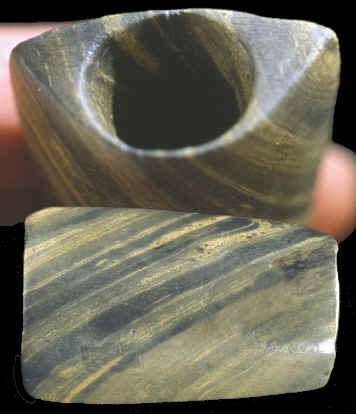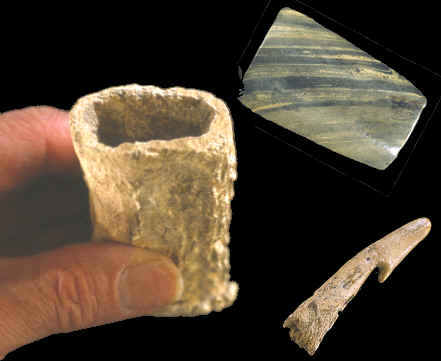|
|
|
The earliest depictions of atlatls in North America are found in pictographs. Atlatls are recorded in rock art in three locations in the U.S. In western Texas and southeastern Utah, atlatls are illustrated without banner-stone weights. In southeastern California, the rock art shows many examples of atlatls with banner-stone weights. These images show a considerable diversity of banner stone weight styles and finger grips. The banner-stone weights are also shown in highly stylized and exaggerated size forms. |
|
|
|
|
Complete examples of ancient spear throwers found in North America are rare. Most of their construction was made from organic materials like antler, bone, shell and wood. Wood was the main material used in their construction, but unfortunately it's the first organic material to decay. Unless they were preserved in such places as dry caves or in frozen tundra and ice they have a poor survival rate. Mostly, just parts of them are found such as the hooks, handles or banner & boat-stone weights. |
|
|
|
|
The atlatl illustrated in this article was found several years ago by William Miller in Davis County, Indiana. When atlatls like this one are found in an excavation, it's obvious to the archaeologist that the handle, banner-stone and hook are part of one complete unit. Only the wooden shaft is missing that once held them together. Experimental archaeologists have reconstructed them and proved their effectiveness. In fact, there are many people in the U.S. that are throwing atlatls in throwing contests and the sport seems to be growing. |
|
|
|
|
In North America, spear or dart throwers were used by Stone Age people for thousands of years longer than the bow and arrow. Although it's not proven, many archaeologists believe that Clovis people were using atlatls in North America twelve or fourteen thousand years ago. The bow and arrow began to be used about 2,000 years ago. In some areas they were still being used when the first Europeans arrived. Spear throwers represent one of the most successful highly developed primitive weapons ever invented. |
|
|
"REFERENCES"
1939,
Knoblock, Byron W., "Banner-stones of the North American
Indian," pp. 148-149. |
|



